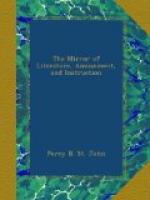O, for that small, small beer anew!
And (heaven’s own type) that mild
sky-blue
That wash’d my sweet
meals down!
The master even!—and that small
turk
That fagg’d me!—worse
is now my work,—
A fag; for all the town!
The “Arabian Nights’”
rehears’d in bed!
The “Fairy Tales” in school-time
read
By stealth, ’twixt verb
and noun!
The angel form that always walk’d
In all my dreams, and look’d, and
talk’d.
Exactly like Miss Brown!
The omne bene—Christmas
come!
The prize of merit, won for home’—
Merit had prizes then!
But now I write for days and days
For fame—a deal of empty praise,
Without the silver pen.
Then home, sweet home! the crowded coach—
The joyous shout—the loud approach—
The winding horn like ram’s!
The meeting sweet that made me thrill,
The sweetmeats almost sweeter still,
No “satis”
to the “jams!”
* * * * *
ENGLISH DRESS.
(To the Editor of the Mirror.)
Mr. Editor.—In No. 200 of the MIRROR, you will find an article, entitled Female Fashions during the early part of the Last Century. The author then promised to give a description of the dress of the English gentlemen of the same period, but as no such description has yet appeared in your pages, I trust you will insert the annexed at your first convenient opportunity.
G.W.N.
Dress of the English Gentlemen during the Early part of the Last Century.
In the reign of King William III., the English gentlemen affected to dress like their dependents. Their hats were laced, and their coats and waistcoats were embroidered with gold and silver fringe; indeed it really became extremely difficult to distinguish a man of quality from one of his lackeys. They did not, however, long persevere in this ridiculous imitation, for they soon afterwards, like the ladies, servilely followed the French fashions. The great partiality of the English beau monde towards the bon ton of France, was a wonderful advantage to that country—an advantage which the English government in vain endeavoured to abolish, although a heavy duty was imposed on all French ribbon and lace imported into this kingdom. Many millions were annually expended in French cambric, muslin, ribbon, and lace, which useless expenditure very sensibly injured our commercial transactions with other nations.
Perukes and long wigs were worn at the revolution; but these being greatly inconvenient in all weathers, some people tied up their wigs, which was the first occasion of short wigs coming into fashion. Some few years afterwards, bob-wigs were adopted by the gentlemen, especially by those of the army and the navy.




